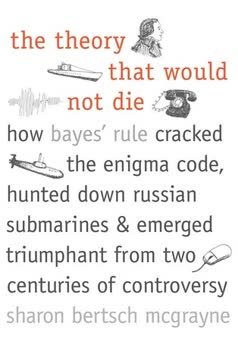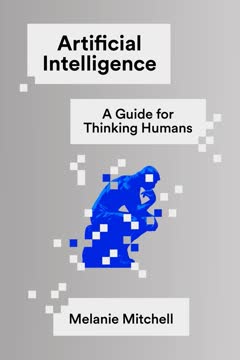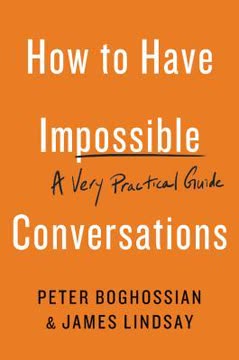Key Takeaways
1. False beliefs persist and spread through social networks, not just individual psychology
Our beliefs about the world matter. They matter to decisions we make every day.
Social transmission of knowledge. Humans rely heavily on learning from others, rather than only from direct experience. This allows us to accumulate vast amounts of knowledge as a species, but also opens the door for false beliefs to spread. Even intelligent, rational individuals can end up holding false beliefs if that's what they're exposed to in their social networks.
Network effects on belief. Mathematical models show that the structure of social networks strongly influences how beliefs spread. Tightly connected groups can reinforce and amplify beliefs, whether true or false. Limited connections between groups can prevent accurate information from spreading widely. These network effects explain how false beliefs can persist even in the face of contradictory evidence.
Key factors in belief spread:
- Network structure (e.g. tightly vs loosely connected)
- Trust between individuals
- Conformity pressures
- Reputation and authority of information sources
2. Scientists can reach false consensuses due to social influences and conformity
Scientists are just like the rest of us, are strongly influenced by their networks of social connections.
Scientific consensus is social. While we often think of science as an objective pursuit of truth, scientists are human and subject to the same social influences as everyone else. Scientific communities can converge on false beliefs through mechanisms like:
- Conformity to prestigious peers
- Distrust of those with different views
- Limited communication between subgroups
Dangers of over-communication. Paradoxically, models show that sometimes less communication between scientists leads to better outcomes. When scientists share results too readily, early misleading data can sway the whole community. Some diversity of beliefs and approaches is crucial for discovering truth.
Historical examples of persistent false scientific beliefs:
- Stomach ulcers caused by stress rather than bacteria
- Dismissal of continental drift theory
- Rejection of hand-washing to prevent disease spread
3. Industrial propaganda exploits social dynamics to manipulate public beliefs
Doubt is our product since it is the best means of competing with the 'body of fact' that exists in the mind of the public.
Tobacco Strategy. The tobacco industry pioneered sophisticated propaganda techniques to sow doubt about the health risks of smoking. Key tactics included:
- Funding biased research
- Selectively promoting favorable studies
- Exploiting journalistic norms of "balance"
- Weaponizing scientific uncertainty
Generalizing propaganda tactics. Similar strategies have been used by other industries to mislead the public on issues like climate change, pharmaceuticals, and nutrition. By exploiting social trust, network effects, and media incentives, relatively small interventions can have outsized impacts on public beliefs.
Common propaganda techniques:
- Creating fake experts and organizations
- Exploiting reputation of real experts
- Selective sharing of real but misleading studies
- Promoting uncertainty and "teach the controversy"
4. Polarization arises from distrust and conformity, not just differing values
Polarization has been studied in many disciplines. There is a large literature, for instance, looking for explanations of polarization in individual psychology.
Trust-based polarization. Mathematical models show how polarization can arise even when everyone is trying to find the truth. As people come to distrust those with different views, they stop updating their beliefs based on evidence from the other "side." This can lead to stable, opposing camps even without any underlying value differences.
Conformity effects. The human desire to conform with one's social group can also drive polarization. People may suppress doubts or avoid sharing contradictory evidence to fit in. In tightly connected groups, this conformity pressure can make beliefs very resistant to change.
Factors contributing to polarization:
- Echo chambers and filter bubbles
- Tribalism and group identity
- Reputation costs of changing views
- Difficulty of evaluating complex evidence
5. Media and social platforms amplify misinformation through algorithmic and economic incentives
Fake news has been with us for a long time. And yet something has changed—gradually over the past decade, and then suddenly during the lead-up to the 2016 UK Brexit vote and US election.
Algorithmic amplification. Social media algorithms designed to maximize engagement often end up promoting sensational and extreme content, including misinformation. The vast reach of these platforms allows false stories to spread farther and faster than ever before.
Economic incentives. Traditional media faces economic pressure to produce attention-grabbing stories, which can lead to amplifying misinformation or creating false equivalencies between reliable and unreliable sources. The internet has also created new economic models for producing pure misinformation.
Changes amplifying misinformation spread:
- Social media networks connecting billions
- Algorithmic content curation and recommendation
- Decline of traditional journalistic gatekeepers
- Ease of creating and monetizing fake news sites
6. Democratic institutions are vulnerable to manipulation of public beliefs
Can democracy survive in an age of fake news?
Informed citizenry crucial. Democratic theory assumes citizens can make informed choices about policies and leaders. But if public beliefs can be easily manipulated, this undermines the very foundation of democracy.
Policy consequences. False beliefs about issues like climate change, vaccines, or economic policies can lead to disastrous real-world outcomes. Democratic institutions currently lack robust defenses against coordinated misinformation campaigns.
Vulnerabilities in democratic systems:
- Voter susceptibility to emotional appeals and simple narratives
- Difficulty evaluating complex policy issues
- Exploitation of wedge issues to divide electorate
- Foreign interference in domestic discourse and elections
7. Combating misinformation requires understanding and addressing its social dynamics
We need to recognize fake news as a profound problem that requires accountability and investment to solve.
Multi-faceted approach needed. Simply fact-checking or educating individuals is not enough. Effective responses must address the social systems that allow misinformation to flourish, including:
- Reforming social media algorithms and business models
- Strengthening journalistic norms and institutions
- Improving scientific communication practices
- Developing new regulatory frameworks
Ongoing challenge. There is no simple solution to the problem of misinformation. As detection methods improve, so too will techniques for creating and spreading false beliefs. Societies must remain vigilant and adaptive to protect the integrity of public discourse.
Potential interventions:
- Algorithmic changes to reduce spread of low-quality information
- Improved science communication and consensus-building practices
- Media literacy education
- Regulation of political advertising and coordinated disinformation campaigns
Last updated:
FAQ
What's The Misinformation Age about?
- Exploration of false beliefs: The book delves into how false beliefs are formed, spread, and persist, particularly through misinformation and social networks.
- Historical and modern examples: It uses both historical anecdotes and contemporary cases, like fake news during elections, to illustrate belief formation mechanisms.
- Social dynamics focus: The authors emphasize that social factors, rather than just individual psychology, are crucial in how beliefs are adopted and maintained.
Why should I read The Misinformation Age?
- Understanding misinformation: The book offers insights into misinformation mechanisms, crucial in today's digital age where false information spreads rapidly.
- Practical implications: It highlights the consequences of false beliefs on decision-making, stressing the importance of critical thinking and evidence-based beliefs.
- Interdisciplinary approach: Combining philosophy, science, and social theory, it serves as a rich resource for understanding knowledge and belief complexities.
What are the key takeaways of The Misinformation Age?
- Beliefs influence decisions: The book stresses that beliefs significantly impact decisions, affecting areas like public health and policy.
- Social networks' role: It highlights how social interactions can spread both true and false beliefs, complicating truth pursuit.
- Critical evaluation need: The authors advocate for discerning information evaluation, urging readers to critically assess sources and evidence.
What are the best quotes from The Misinformation Age and what do they mean?
- “Our beliefs about the world matter.” This underscores the importance of beliefs in shaping actions and decisions, highlighting real-world consequences of false beliefs.
- “Widespread falsehood is a necessary, but harmful, corollary to our most powerful tools for learning truths.” This reflects the paradox of social learning, where mechanisms for acquiring knowledge can also spread misinformation.
- “The marketplace of ideas is a fiction, and a dangerous one.” This critiques the notion that free discourse naturally leads to truth, emphasizing vigilance against misinformation.
How do social networks influence belief formation according to The Misinformation Age?
- Information sharing: Beliefs often form based on what others in social networks believe, not just personal experience or evidence.
- Conformity effects: Individuals may conform to peers' beliefs, even when contradicting evidence, leading to persistent false beliefs.
- Echo chambers: The book highlights dangers of social media echo chambers, where individuals only encounter information reinforcing existing beliefs.
What role does propaganda play in spreading misinformation as discussed in The Misinformation Age?
- Deliberate misinformation: Propaganda creates doubt and confusion about established facts, often for political or commercial gain.
- Tobacco Strategy example: The book details how the tobacco industry used propaganda to obscure smoking health risks, showing systematic misinformation propagation.
- Impact on public perception: Propaganda significantly shapes public beliefs and policy decisions, often leading to harmful societal consequences.
What is the Zollman effect mentioned in The Misinformation Age?
- Communication pitfalls: The Zollman effect describes how increased communication among scientists can lead to consensus on false beliefs, especially with complex problems.
- Diversity of beliefs: Some belief diversity within scientific communities can be beneficial, allowing exploration of alternative hypotheses and preventing groupthink.
- Scientific inquiry implications: It highlights the importance of balancing collaboration and independent inquiry in research to avoid conformity pitfalls.
How does The Misinformation Age address the issue of trust in information sources?
- Trust dynamics: Trust in information sources is crucial for belief formation, with individuals often relying on the credibility of information sharers.
- Reputation weaponization: Reputations can be manipulated by propagandists to influence public opinion, as seen with Roger Revelle and climate change.
- Critical evaluation: The authors advocate for discerning source evaluation, emphasizing the need to consider motivations and biases of information providers.
How can individuals combat misinformation according to The Misinformation Age?
- Critical thinking: The book encourages adopting a critical mindset when consuming information, questioning sources and seeking evidence before forming beliefs.
- Engagement with diverse perspectives: It advocates for engaging with various viewpoints to avoid echo chambers and broaden understanding of complex issues.
- Promoting scientific literacy: Emphasizing scientific literacy, the authors suggest better education about scientific methods to help navigate misinformation effectively.
How does The Misinformation Age explain the spread of false beliefs?
- Social influence mechanisms: Social influence, like conformity and peer pressure, can lead to adopting false beliefs, creating echo chambers where misinformation thrives.
- Case studies: Examples like the anti-vaccine movement illustrate misinformation spread within tightly-knit communities, providing concrete evidence of theoretical claims.
- Role of media: Media platforms amplify misinformation, particularly through algorithms prioritizing engagement over accuracy, allowing false information to reach wide audiences quickly.
What methods does the author suggest for combating misinformation?
- Promoting critical thinking: Education emphasizing critical thinking skills can help individuals better evaluate information they encounter.
- Improving media literacy: Enhancing media literacy helps discern credible sources from unreliable ones, understanding how algorithms shape information landscapes.
- Encouraging diverse viewpoints: Exposing individuals to a range of perspectives can counteract echo chambers and promote nuanced understanding of complex issues.
What are the implications of misinformation for democracy as discussed in The Misinformation Age?
- Threat to informed decision-making: Misinformation undermines citizens' ability to make informed choices, essential for a functioning democracy.
- Polarization effects: Misinformation contributes to political polarization, complicating constructive dialogue and consensus.
- Call for action: Understanding misinformation mechanisms is crucial for developing effective strategies to combat it and protect democratic processes.
Review Summary
The Misinformation Age explores how false beliefs spread through social networks, even among scientists. It examines case studies like climate change denial and tobacco industry propaganda to illustrate how misinformation proliferates. The authors use mathematical models to explain belief formation and propagation. While some readers found it dry or overly academic, many praised its insights into the mechanisms behind fake news and scientific consensus. The book concludes with suggestions for combating misinformation, including reimagining democracy to be more responsive to facts and expert knowledge.
Similar Books










Download PDF
Download EPUB
.epub digital book format is ideal for reading ebooks on phones, tablets, and e-readers.




